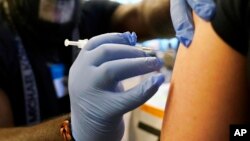COVAX, the global program for distributing COVID-19 vaccines to poorer countries, will soon be integrated into more routine vaccination programs, GAVI said Thursday.
GAVI, the nonprofit vaccine alliance that provides an array of vaccines to developing countries, said its board agreed during a meeting in Geneva to phase out COVAX after 2023, stressing that the COVID-19 vaccine would still be made available to less well-off countries, alongside other vaccines.
"While COVAX continues to have in place plans for worst-case scenarios, the board agreed, in principle, to explore integrating future COVID-19 vaccinations into GAVI's core programming," it said in a statement.
The aim, it said, is "to improve synergies, be more responsive to countries' needs," and to reduce the current burden on countries of having a specialized emergency response in place.
It has taken the lead on the COVAX initiative, alongside the World Health Organization and the Coalition for Epidemic Preparedness Innovations.
The global scheme has so far shipped more than 1.86 billion COVID-19 vaccinations doses to 146 territories, with the focus on providing donor-funded jabs to the 92 weakest economies.
"The support is continuing in 2023," GAVI's head of resource mobilization, Marie-Ange Saraka-Yao, told AFP.
"Then, of course, depending on how the pandemic evolves, the plan will be to really bring it into the more regular program," she said, adding that this was what countries were asking for.
"It doesn't disappear, but it is really integrated."
Acute pandemic phase 'fading'
This would allow people to combine getting a COVID-19 vaccine with receiving other vaccines, helping to counter the "backsliding" in routine vaccination since the start of the pandemic.
It could also drive up demand for COVID-19 vaccinations, Saraka-Yao said.
"We think that's actually the best way to improve and to accelerate the demand," she said.
COVAX was launched in June 2020, when few could have imagined that several highly effective vaccines would emerge within nine months.
The program was created to help counter the stark disparity in access to the vaccines that arose as wealthy countries scrambled to secure large stashes of various vaccines being developed.
While massive efforts have been made through the program, a yawning gap remains in vaccination rates between the richest and poorest countries.
Three-quarters of people in high-income countries have received at least one COVID vaccine dose, but fewer than a third of people in low-income countries have, according to the United Nations.
Nine countries still have COVID-19 vaccine coverage below 10%.
Despite the remaining coverage gaps, the decision to begin phasing out COVAX was not completely unexpected.
"It is acknowledging that the acute phase [of the pandemic] seems to be fading," Saraka-Yao said, stressing that the focus was on "flexibility," and that there was enough "capacity to continue fully in 2024."







